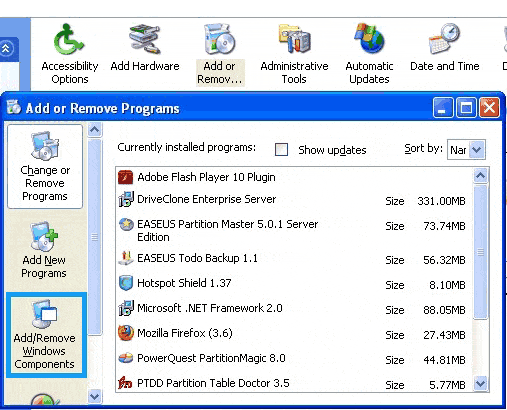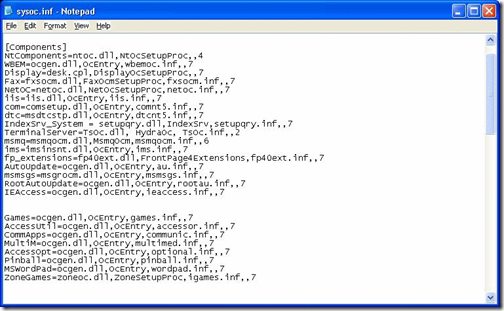Add Remove Windows Components Windows 7
Hi everyone, I'm trying to work out OSD deployment and sysprep and I feel like a total tool asking for help here. I'm reading guides all over the place and I feel like I've almost got it but I've hit a serious mental block. Currently: Am deploying OSes easily, running a task sequence which installs the required software packages no problem, etc etc. Am pretty confident with that.
However, I've noticed that imaged machines have Outlook Express, MSN Explorer etc installed, which I removed before capturing the reference image. I've come to realise that sysprep must be bring the installation back to a default state, and that you can somehow use sysprep to tell it to not install packages. I've read the sysprep help file from the deploy.cab, and I'm just confused as to how to do it.
Here's is my current procedure: 1. Receive new computer system. Use a WindowsXP SP3 VLK CD to do a clean install. Install base drivers I want.
Remove 'User' account, leaving only Administrator account, and use 'Add/Remove Windows Components'. Install a software package that I've decided is far to unreliable for packaging (Thanks HP, awesome software guys:thumbsup:) 5. Copy sysprep folder to C: 6. Use Capture Media CD to take image.
Windows Old Files Windows 7
Create new task sequence using this image, copy over the custom steps from an already made task sequence. Image desktops of the same type. When creating the Task Sequence for the OS installation, the questions it asks about User, Organization and Product Key etc etc match up to what I imagine sysprep would be answering (surprise surprise). So even if I do work out how to use sysprep to remove windows components during the install, I'm concerned that this will break that feature? End result I'm looking for: Same image capturing process, but with the Windows Components that I want removed, removed. Correct on the unattend.txt usage except that unattend.txt is only for fresh installs of a system, not syspreped images.
Thus, the build and capture task sequence. For driver control, you can use an install driver package task that copies over only the drivers in a specific driver package. There are varying opinions on the best way to install drivers using OSD and they fall into a spectrum with control-freak on one end and choas on the other end. Basically, there are two driver tasks; apply driver package and auto apply drivers. Auto apply uses a PNP detection process to identify drivers and copy those to the system for potential use by Windows. The Apply driver package simply copies all of the drivers in a specific package over to the destination systems for potential use by Windows. Notice the 'potential use', in both cases, the drivers are made available to Windows setup but it ultiimately chooses which drivers to use.

Another thing to keep in mind with images is that you should include as few extra drivers as possible in the image - a goal for your images is to make them hardware agnostic. Adding additional hardware drivers should be part of your deployment task sequence.Jason http://myitforum.com/cs2/blogs/jsandys. Hi Andrew.Since you need to remove Outlook Express, I guess we are talking about Windows XP. You can remove unvented components by using an answer file (unattend.txt) while building your reference machine. Once removed/disabled they will not reaper after a sysprep.In your image deploy step in your TS, just point to the answer file, located in a package.If you install MDT you can find a pretty comprehensive one at C:Program FilesMicrosoft Deployment ToolkitTemplatesUnattend.txt that you can use as a guideline.Michael Petersenhttp://kongkuba1.spaces.live.com. Correct on the unattend.txt usage except that unattend.txt is only for fresh installs of a system, not syspreped images.
Thus, the build and capture task sequence. For driver control, you can use an install driver package task that copies over only the drivers in a specific driver package. There are varying opinions on the best way to install drivers using OSD and they fall into a spectrum with control-freak on one end and choas on the other end. Basically, there are two driver tasks; apply driver package and auto apply drivers. Auto apply uses a PNP detection process to identify drivers and copy those to the system for potential use by Windows. The Apply driver package simply copies all of the drivers in a specific package over to the destination systems for potential use by Windows.
Notice the 'potential use', in both cases, the drivers are made available to Windows setup but it ultiimately chooses which drivers to use. Another thing to keep in mind with images is that you should include as few extra drivers as possible in the image - a goal for your images is to make them hardware agnostic.
Adding additional hardware drivers should be part of your deployment task sequence.Jason http://myitforum.com/cs2/blogs/jsandys. OK, things are much clearer now. This thread combined with my test lab have helped me tremendously. I don't believe I'll ever be able to do a build and capture method in this environment. The HP app (HPQC) is ridiculously temperamental and only seems to work if you install it via the website.
Using the install files from the server (the very same files the website calls and the files that are recommended for offline installs) and trying to install manually rarely works, and I don't think it's ever going to be reliable enough for packaging, so I have to use images with the package already installed which can't be done with the build and capture method. I am trying the sysocmgr option at the moment, running a manual batch file as a test has worked, am trying the OSD now.


Similar help and support threadsThreadForumHi guys just installed office 2016. Didn't give me any options during the install now I want to remove some of the apps it put on that I don't need eg. Publisher one note PowerPointAny ideas?Microsoft OfficeHiI recently bought a new motherboard, graphic card and CPU for my computer. Since installing the new parts I've been getting bluescreen, and blackscreen, while ingame (Counter Strike Global:offensive).I've uploaded the BSOD information, and hopefully someone will be able to tell me what is.BSOD Help and SupportNew PC componentsIm mainly gonna be using this PC for my Media CenterThe OS is gonna be on its own SSDAny Advise for me would be appreciated& DevicesDoes anyone have any information on how to COMPLETELY REMOVE the following components?
Not just disable/turn off, i want them GONE, i have no need for them.Windows FirewallWindows DefenderI'm behind a cisco hardware firewall, i do not need firewall, it just consumes memory/resources and.Network & SharingHi everyone.I want to know if my pc components can work on win7.My cmoponents are:-Motherboard AsRock K8NF4G-SATA2-RAM 1536MB (1,5Gb) DDR-Graphics ATI Radeo X300 Seriesc 256Mb di memoria 32bit-CPU AMD Sempron 3000+ 1,8GHz 64bit but I want to install a 32bit version because I haven't.Hardware & DevicesOur SitesSite LinksAbout UsFind Us.